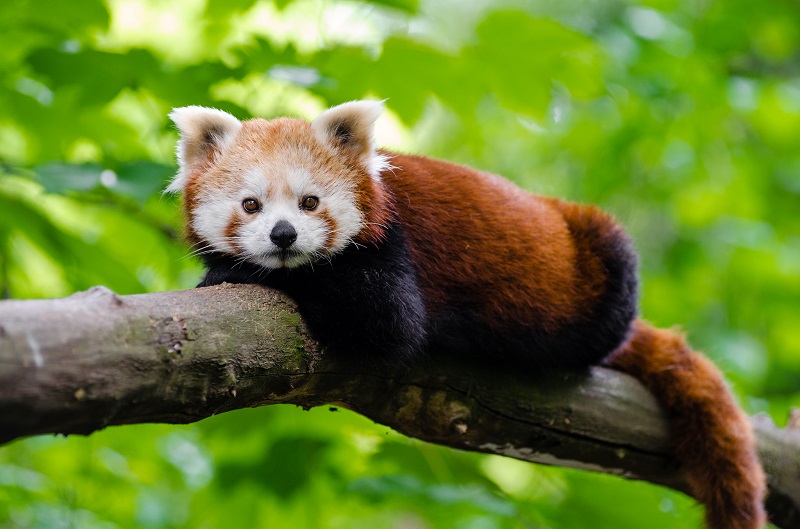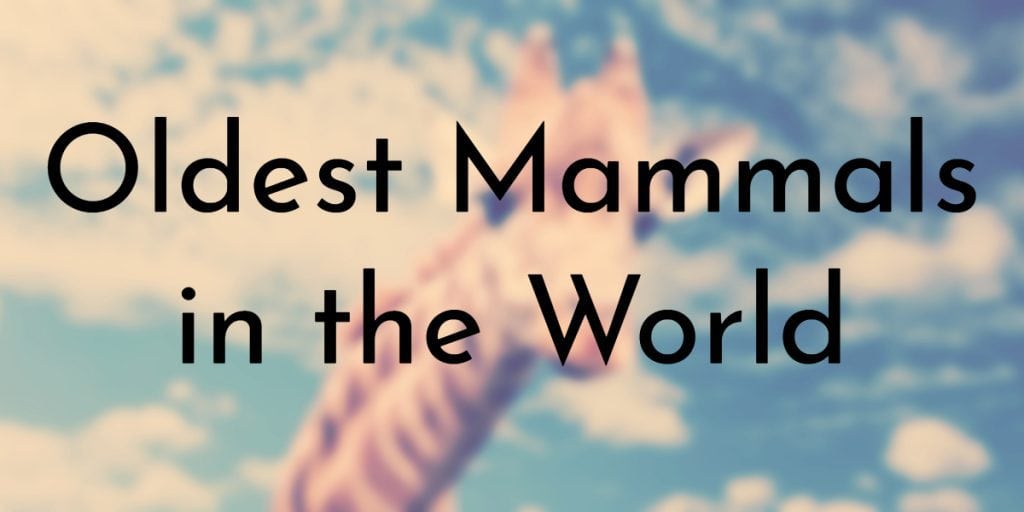Mammals first appeared on Earth about 200 million years ago and unlike the dinosaurs, survived the mass extinction event that took place approximately 66 million years ago. Several mammal groups were also wiped out in the event, but a few small mammal species survived and diversified into new forms. With the exception of the giraffe, all of the mammals on this list are considered living fossils because they closely organisms only known from the fossil record. Additionally, all of these mammals are the only living examples of various animal families.
9. Giraffe
Age: c.12 million years
Location: Savannahs and open woodlands in Africa
Diet: Herbivorous – twigs, grass, shrubs, and fruit

The iconic giraffe is one of the two existing members of the Giraffidae family – the other is the okapi, which is older. The common ancestor of the giraffe and okapi lived about 11.5 million years ago. Recognized by its extremely long neck and legs, the giraffe is the tallest living terrestrial animal in the world. Giraffes also have distinct markings, which is now a popular clothing pattern.
Until recently, giraffes were considered to be only one species but it is now believed that there are at least eight living species of giraffe and seven extinct species. DNA analysis suggests that these distinct species of giraffe have not exchanged genetic information for at least one million years.
8. Okapi
Age: 18 million years
Location: Democratic Republic of the Congo
Diet: Herbivorous – tree leaves and buds, grasses, ferns, fruits, and fungi

Although the okapi (forest giraffe, congolese giraffe, and zebra giraffe) has striped markings and a body shape similar to a zebra, it is related to the giraffe. In fact, the okapi and the giraffe are the only living members of the Giraffidae family. The earliest members of Giraffidae appeared during the Miocene (23.03 – 5.33 million years ago) and the okapi split off the evolutionary branch about 18 million years ago.
Okapis are much smaller with shorter necks than their giraffe cousins, although both animals have seven vertebrae. The okapi’s striking stripe pattern help to camouflage the animal in dense vegetation. They are primarily solitary animals and only come together to breed. Okapis are classified as endangered and are fully protected under Congolese law.
7. Laotian Rock Rat
Age: 32.5 million years
Location: Khammouan region of Laos
Diet: Primarily Herbivorous – leaves, grass, seeds, and occasionally insects

When the Laotian rock rat was first described in 2005, it was put into a new unique family – Laonastidae – because it was so distinct from all living rodents. However, a paleontologist named Mary Dawson and her team suggested that the Laotian rock rat actually belonged to the ancient fossil family Diatomyiade – which was thought to have gone extinct 11 million years ago. Dawson’s research is now widely accepted, and the Laotian rock rat’s existence fills in the gap in the fossil record.
Laotian rock rats have skulls that are distinct and have features that separate them from all other living mammals. They do resemble large rats and have thick tails like squirrels.
6. Red Panda
Age: 33.9 – 23 million years
Location: Himalayas, western Nepal, and eastern China
Diet: Primarily Herbivorous – bamboo, eggs, flowers, berries, and sometimes small mammals and birds

The red panda is the only living representative of the Ailuridae family. Red pandas have no close living relatives and their nearest fossil ancestors lived about 3 – 4 million years ago. Some of the oldest fossils from extinct red panda species are dated to 4.5 – 7 million years ago. In the past, red pandas were considered part of the raccoon family and then the bear family, but red pandas are only distantly related to raccoons and giant pandas.
Red pandas are currently an endangered species with worldwide population estimates ranging from as low as 2,500 to 20,000 individuals. Since red pandas are secretive and mostly nocturnal, it can be hard to observe them and get an accurately measure their population.
5. Shrew Opossum
Age: 37.2 million years
Location: Andes Mountains
Diet: Primarily Insectivorous – insects, earthworms, fruit, and small invertebrates

Not much is known about the shrew opossum, which lives in the inaccessible regions of the western Andes Mountains. Shrew opossums are a rat-like marsupial that does not resemble any of the animals that it is named after. Scientists believe that at one point, there were several species of shrew opossums in South America, but only seven known species exist today.
Although their habitat makes it hard for scientists to conduct research, recent studies suggest shrew opossums are not as rare as previously thought. From the little research that has been conducted, scientists know that elephant shrews have thin limbs, a long, pointed snout, and small eyes with poor eyesight.
4. Monito del monte
Age: 46 million years
Location: Argentina and Chile
Diet: Primarily Insectivorous – insects, invertebrates, and mistletoe fruit

The monito del monte is a South American marsupial that is directly related to the better-known marsupials (kangaroos, koala, wallaby, etc.) of Australia. Researchers believe that the monito del monte is related to the now extinct Djarthia, the earliest known Australian marsupial. The monito del monte’s ancestors most likely came to South America via back-migration from Australia around 46 million years ago when the two continents were still connected.
Monitos del monte live in highlands of Argentina and Chile. Due to several factors such as a limited habitat and the threat of domestic cats, monitos del monte are a near-threatened species and their numbers continue to decline.
3. Elephant Shrew
Age: 47.8 – 41.2 million years
Location: Africa
Diet: Insectivorous – insects, spiders, centipedes, millipedes, and earthworms

Elephant shrews, also known as jumping shrews or sengis, are the only mammals in the family Macroscelididae. In the past, elephant shrews were classified with shrews and hedgehogs – which they look like – but molecular evidence shows that elephant shrews are not related to true shrews. In fact, elephant shrews are more closely related to elephants, which they were named after due to the similarity between their long noses and elephants’ trunks.
Nearly all species of elephant shrew live across southern Africa, with one species (the North African elephant shrew) remaining in the mountainous northwest. Elephant shrews can live in almost any kind of habitat and are known for being one of the fastest small mammals, having been recorded to reach speeds of 28.8 kilometers per hour (17.9 mph).
2. Solenodon
Age: 73.6 million years
Location: Cuba and Hispaniola
Diet: Insectivorous – earthworms and other invertebrates

According to genetic analysis, solenodons split off from other living mammals about 73.6 million years ago. Recent research confirms that solenodons belong to an evolutionary branch that diverged from hedgehogs, moles, and shrews – thus the similar appearance.
There are only two known species of solenodons today, one group lives in Cuba while the other is from the nearby island of Hispaniola. Solenodons have a few unusual traits, such as their venomous saliva, which is a rare mammal characteristic. Not much is known about either species of solenodon and they are considered endangered due to predation by the small Asian mongoose, an invasive species introduced to the Caribbean during colonial times.
1. Monotremes (Platypus and Echidnas)
Age: c.220 – 110 million years
Location: Australia and New Guinea
Diet: Carnivorous – ants, termites, worms, freshwater shrimp, and insect larvae

Monotremes, which include the platypus and echidnas, are the oldest mammals in the world. They are one of the three main groups of mammals and their prehistoric ancestors appeared about 220 million years ago in the fossil record. The duck-billed platypus and a few species of echidnas are the only existing examples of monotremes left on Earth.
All monotremes are indigenous to Australia and New Guinea but there is evidence that they were more widespread. One of the most notable characteristics about monotremes is that they are the only egg-laying mammals left on the planet today.











